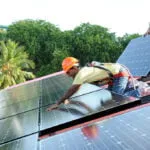As the world continues to tackle climate change and work towards a sustainable future, advancements in energy and sustainability technologies are accelerating. From microreactors to smarter energy grids, emerging technologies are reshaping how we generate, store, and use energy. This blog post explores some of the most exciting and innovative developments in this space, highlighting key trends that will define the energy landscape in 2025 and beyond.
Microreactors: Small Nuclear with Big Potential
Microreactors, a small modular reactor (SMR), are poised to revolutionize the nuclear energy sector. Unlike traditional large-scale reactors, these compact systems can generate up to 20 megawatts of power, making them ideal for providing energy to remote areas or specialized applications like data centers.
The promise of microreactors lies in their ability to deliver reliable, low-carbon power with faster installation times compared to conventional nuclear plants. Companies like Last Energy are working to deploy these reactors on a smaller scale, which could provide a game-changing solution for regions with limited access to traditional energy grids. Despite challenges in funding and regulation, microreactors are an exciting glimpse into the future of nuclear energy.

However, just because the reactor is smaller doesn’t make the nuclear waste any less hazardous or long-lasting. With power demands increasing dramatically, nuclear power may be the only way to prevent coal-burning power plants from operating well into the middle of this century. Stay tuned on this one.
Read more about microreactors’ potential.
Rare Earth Element Recycling: Reducing Dependence on Imports
Rare earth elements (REEs) are critical for producing renewable energy technologies such as wind turbines, solar panels, and electric vehicles. However, the global supply of these elements has been dominated by a few countries, raising concerns over sustainability and geopolitical risks. Enter recycling innovations.
Ionic Technologies, a Belfast-based company, has developed a patented method for extracting high-value rare earth oxides from industrial magnets. This breakthrough reduces the environmental impact of mining and decreases dependence on foreign supplies. Recycling these valuable materials can close the rare earth supply chain loop, making renewable energy technologies more sustainable and accessible.
Learn more about rare earth element recycling.
Advanced Energy Storage Systems: Powering the Future with Better Batteries
As renewable energy sources like solar and wind power become more widespread, reliable energy storage systems are essential for ensuring a stable and consistent energy supply. Recent innovations in battery technologies are making this a reality.
Solid-state and flow batteries are two cutting-edge developments that promise to improve energy storage efficiency, scalability, and safety. These technologies are more efficient than traditional lithium-ion batteries and offer longer life cycles and faster charging times, which are essential for integrating renewable energy into the grid and powering everything from homes to electric vehicles.
Explore the latest in advanced energy storage.

Smart Grids and AI: Making Energy Distribution Smarter
The future of energy distribution is intelligent. Smart grids powered by artificial intelligence (AI) transform how energy is delivered to homes and businesses. AI allows for real-time analysis of energy usage, enabling grid operators to make adjustments on the fly to prevent energy waste and optimize performance.
One of AI’s key benefits in energy management is its ability to predict and respond to changes in demand. By incorporating renewable energy sources more efficiently and adjusting to fluctuations in energy usage, AI-driven smart grids help reduce energy waste and enhance the grid’s resilience.
Read more about AI-powered smart grids.
Energy-Sustainable IoT Connectivity: Building Greener Cities
The Internet of Things (IoT) is already changing the way we live, but in 2025, it’s becoming even more sustainable. IoT systems designed with energy efficiency are being deployed in smart cities and buildings, reducing energy consumption and lowering carbon footprints.
These systems use renewable energy sources, such as solar power, to run IoT devices and optimize energy usage across entire buildings or urban areas. The future of IoT connectivity isn’t just about making life more convenient—it’s about making it more sustainable.
Learn more about energy-sustainable IoT systems.

Enhanced Geothermal Systems (EGS): Tapping into Earth’s Heat
Geothermal energy has long been a reliable source of clean energy, but its potential has been limited by geography. Enhanced Geothermal Systems (EGS) aim to change that by enabling geothermal energy production in regions without traditional geothermal resources.
EGS involves injecting water into hot, dry rock formations deep underground, creating artificial reservoirs that can be tapped for energy. This technology has the potential to unlock vast amounts of clean, baseload power, making geothermal a key player in the global push for renewable energy. While challenges such as high drilling costs remain, ongoing research is expected to drive further breakthroughs.
Explore the future of Enhanced Geothermal Systems.

Energy and Sustainability: An Essential Marriage
An exciting range of emerging technologies is shaping the future of energy and sustainability. From microreactors to AI-powered grids and sustainable IoT systems, these innovations promise to make energy generation, storage, and consumption more efficient and environmentally friendly. As these technologies continue to evolve, they hold the potential to accelerate our transition to a sustainable, low-carbon future.
What sustainable energy sources are you watching? Let us know in the comments.
Stay tuned to Green Living Insider for insights on how emerging technologies drive energy innovation and sustainability. Don’t forget to subscribe for green living tips sent straight to your inbox.





